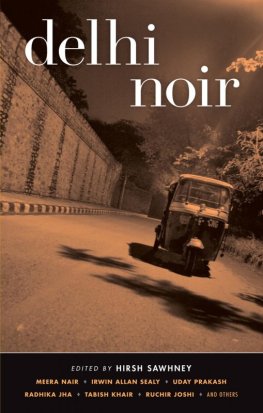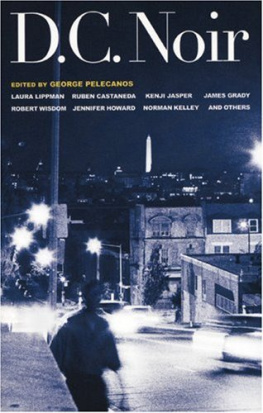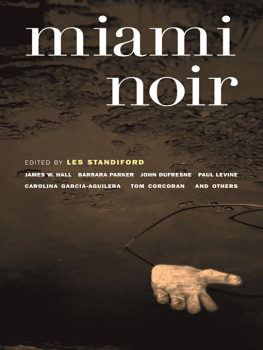
This collection is comprised of works of fiction. All names, characters, places, and incidents are the product of the authors imaginations. Any resemblance to real events or persons, living or dead, is entirely coincidental.
Published by Akashic Books
2009 Akashic Books
Series concept by Tim McLoughlin and Johnny Temple Delhi map by Sohrab Habibion
ePUB ISBN-13: 978-1-936-07026-8
ISBN-13: 978-1-933354-78-1
Library of Congress Control Number: 2008937355
All rights reserved
Akashic Books
PO Box 1456
New York, NY 10009
info@akashicbooks.com
www.akashicbooks.com
ALSO IN THE AKASHIC NOIR SERIES:
Baltimore Noir, edited by Laura Lippman
Bronx Noir, edited by S.J. Rozan
Brooklyn Noir, edited by Tim McLoughlin
Brooklyn Noir 2: The Classics, edited by Tim McLoughlin
Brooklyn Noir 3: Nothing but the Truth
edited by Tim McLoughlin & Th omas Adcock
Chicago Noir, edited by Neal Pollack
D.C. Noir, edited by George Pelecanos
D.C. Noir 2: The Classics, edited by George Pelecanos
Detroit Noir, edited by E.J. Olsen & John C. Hocking
Dublin Noir (Ireland), edited by Ken Bruen
Havana Noir (Cuba), edited by Achy Obejas
Istanbul Noir (Turkey), edited by Mustafa Ziyalan & Amy Spangler
Las Vegas Noir, edited by Jarret Keene & Todd James Pierce
London Noir (England), edited by Cathi Unsworth
Los Angeles Noir, edited by Denise Hamilton
Manhattan Noir, edited by Lawrence Block
Manhattan Noir 2: The Classics, edited by Lawrence Block
Miami Noir, edited by Les Standiford
New Orleans Noir, edited by Julie Smith
Paris Noir (France), edited by Aurlien Masson
Portland Noir, edited by Kevin Sampsell
Queens Noir, edited by Robert Knightly
Rome Noir (Italy), edited by Chiara Stangalino & Maxim Jakubowski
San Francisco Noir, edited by Peter Maravelis
San Francisco Noir 2: The Classics, edited by Peter Maravelis
Seattle Noir, edited by Curt Colbert
Toronto Noir (Canada), edited by Janine Armin & Nathaniel G. Moore
Trinidad Noir, Lisa Allen-Agostini & Jeanne Mason
Twin Cities Noir, edited by Julie Schaper & Steven Horwitz
Wall Street Noir, edited by Peter Spiegelman
FORTHCOMING:
Barcelona Noir (Spain), edited by Adriana Lopez & Carmen Ospina
Boston Noir, edited by Dennis Lehane
Copenhagen Noir (Denmark), edited by Bo Tao Michaelis
Haiti Noir, edited by Edwidge Danticat
Indian Country Noir, edited by Liz Martnez & Sarah Cortez
Lagos Noir (Nigeria), edited by Chris Abani
Lone Star Noir, edited by Bobby Byrd & John Byrd
Los Angeles Noir 2: The Classics, edited by Denise Hamilton
Mexico City Noir (Mexico), edited by Paco I. Taibo II
Moscow Noir (Russia), edited by Natalia Smirnova & Julia Goumen
Mumbai Noir (India), edited by Altaf Tyrewala
Orange County Noir, edited by Gary Phillips
Phoenix Noir, edited by Patrick Millikin
Richmond Noir, edited by Andrew Blossom,
Brian Castleberry & Tom De Have
In memory of Shiv Lal Sawhney
19332009
TABLE OF CONTENTS
Ashram
Yesterday Man
Lodhi Gardens
How I Lost My Clothes
Delhi Ridge
Last In, First Out
Nizamuddin West
Parking
R.K. Puram
Hissing Cobras
Paharganj
The Railway Aunty
Delhi University,
Hostel
Inter State Bus Terminal
small fry
Defence Colony
Fit of Rage
Gyan Kunj
Just Another Death
Green Park
Gautam Under a Tree
Jantar Mantar
The Scam
Rohini
The Walls of Delhi
(Translated from Hindi by Jason Grunebaum)
Bhalswa
Cull
D elhi, a city thats been reborn in various locations and forms throughout its thousands of years of history, was in the midst of yet another colossal transition when I arrived here four years ago. This latest metamorphosis was being fueled by legislation that opened up India to private and foreign investors. International brands like the Wall StreetJournal and Chanel were setting up shop. The citys cruddy public transportation system was being revolutionized by an ultramodern metro. My mothers massive Punjabi familyPartition refugees whod happily lived in a one-bedroom Con-naught Place flat during the 1950swere driving Hondas and Hyundais and comparing plasma television prices.
For the first time in decades, members of the educated elite were experiencing a gleeful surge of nationalism, and they wanted to savor it. They bragged about the new malls and cinemas going up in Gurgaon, a quasi-American suburb in which civic planning plays second fiddle to corporate whims. They reveled in the number of billionaires who called their city home, as well as the rising values of the houses their parents had built. But things werentand arentas good as everyone wanted to believe.
Every morning, papers abound with alarming stories: accounts of the unmitigated corruption and contract killing that make this city of more than fifteen million tick; indications of increasing divisions between rich and poor that lead servants to murder masters and foment Maoist movements in the countrys hinterland; synopses of so many rapes and sexual assaults that readers become numb to them. Yet the everyday depravity and anguish of Delhi life remains confined to news copy. Despite notable exceptions like Namita Gokhale and Arvind Adiga, authors of literatureparticularly those who write in Englishusually choose to ignore the capitals stains.
Other Indian metropolises have had writers whove chronicled the perils of urban existence, and some of these individuals have done so by employing the devices of crime and detective fiction. Mumbai, Indias film capital, lays claim over Vikram Chandra, who published the mammoth noir tomb SacredGames, and Altaf Tyrewala, who wrote an impressive slim book called No God in Sight. Looking futher back, the iconic Urdu author Saadat Hasan Manto called Bombay home, even though his macabre stories were set in different locations. The legendary Bengali filmmaker Satyajit Ray also wrote detective stories, as did Bengali Sharadindu Bandyopadhyay, whose enigmatic Sherlock Holmes-esque Byomkesh Bakshi mysteries are set in Calcutta.
What then explains the lack of noir literatureand fiction in generalset in Delhi? The answer may be simple. Good crime fiction, however seductive and pleasurable, forces readers to reckon with the inequity and cruelty inherent to modern societies. Its only natural that Delhis book-buying-and-publishing citizens would avoid such writing. Any insight into their hometowns ugly entrails would threaten their guilt-free gilded existence and the bubble of nationalistic euphoria in which their lives are contained. They are too dependent on the power structures and social systems intrinsic to the cityembassies, government offices, and corporations; rural poverty and illegal immigrationto risk looking critically at these things.
Thankfully, there are writers who are willing to see Delhi as it is, and this anthology contains stories by fourteen of them. Delhi Noirs contributors are diverse: They are Christians, Hindus, Muslims, Sikhs; Punjabis, Biharis, Bengalis, and Ker-alites; men and women; gay and straight. Many reside in the capital, but others have addresses in Uttarakhand or the U.S. Some have published critically acclaimed books, and a few are still working on their first manuscripts. What they have in common is the inclination to write delectable literature that doesnt shy away from the citys uncomfortable underside. Their fiction isnt politically correct and refuses to pander to popular perceptions about India or its capital, perceptions that conform with the agendas of governments, glossy magazines, and multinational corporations.
Next page














